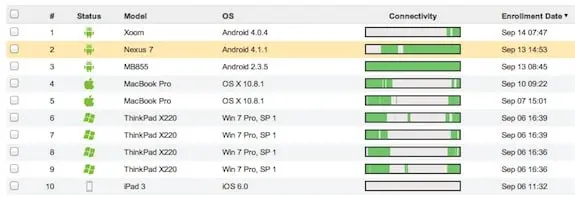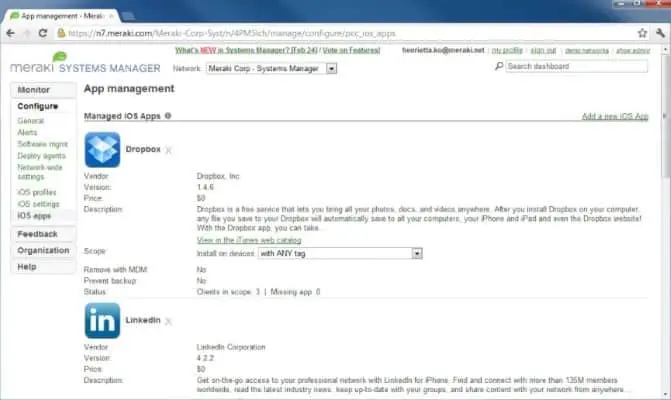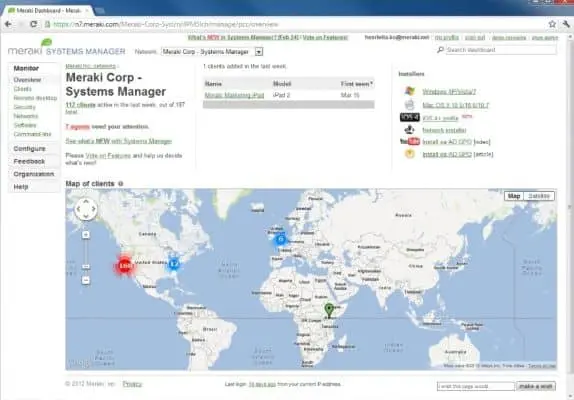Cisco Meraki Systems Manager can provide your organization with smart enrolling choices, MDM capabilities, and compatibility for the majority of corporate operating systems. If you are not sure about the service and want to know more about it, here is a review of Cisco Meraki Systems Manager.
What you will see?
Cisco Meraki Systems Manager
Mobile devices are an important component of a company’s strategy. The IT teams of your company will need the necessary tools to administer phones, tablets, laptops, and hybrid devices, whether they’re maintaining corporate hardware or managing the new BYOD policy. Mobile Device Management (MDM) software can help with this. MDM is installed on each device and linked to a central server-based administration tool. It allows IT teams to keep track of permissions, regulate user access, track device location, manage loaded apps, and more. For different enterprises, there are a variety of MDM suites to choose from. Systems Manager, one of the Cisco Meraki family’s business-centric solutions, is one of them.
Pros
- Good compatibility
- Pricing is good but dependent on the wider use of Cisco hardware
Cons
- It needs the adoption of Cisco Meraki for the Systems Manager to work
- The system relies on Cisco Meraki hardware such as MX Security Appliances and MS Switches.
What is Cisco MDM?

MDM enables the entire administration of mobile and PC devices. It gives you provision settings and limitations, lets you manage inventory and device tracking, and remotely erases a complete device or only the managed applications and data. It also enables monitoring and troubleshooting remotely utilizing the included native remote desktop capability. Meraki MDM Systems Manager allows you to securely manage mobile devices from the cloud.
Basically, you can control and manage mobile devices in the same way as the Meraki hardware. With this, you can monitor and control all of your Meraki products from a single interface. It’s also incredibly clean, basic, and straightforward to use. Moreover, employees can use their own devices to access company assets and data with Meraki MDM. Also, they can do it in the safest way possible. You can control thousands of devices and computers from a single location.
Meraki Systems Manager is compatible with Android, iOS, Mac OS X, and Windows. Furthermore, devices automatically retrieve security policies and configurations from the cloud. With the help of Trusted Access, it may even specify how long a device has access to assets.
Price
The most important thing you need to remember before getting Cisco Meraki Systems Manager is that you first need Cisco Meraki hardware and network infrastructure. So, if you don’t already have the Meraki system in your company, the total cost will go quite high. On top of the existing Cisco Meraki licensing agreement, Systems Manager costs an extra $40 per year per admin system. This is highly beneficial in terms of device management. Most MDM services charge $5 per month per device as a baseline license. Clearly, having a Cisco Meraki system already installed is a significant benefit. However, given the price of migrating from your current network arrangement to Meraki, adopting Systems Manager would appear to be impractical. Although, that is unless other migrations go through proper evaluation and approval. You would also require MX Security Appliances, MS Switches, and MR Wireless Local Area Network hardware for optimal functionality.
Features
The primary goal of MDM software is to ensure that all mobile devices are operating securely, safely, and to their full potential. For this to efficiently work, Cisco Meraki Systems Manager provides customized security rules, certificate-based enrolment, and encryption management. The IT team can control all the device settings, apps, and content access. It can even remove privileges if policies are broken. Diagnostic tools help with device debugging and administration. It can even restrict (or disable on BYOD devices) third-party cloud apps to secure corporate data. Also, you can create hardware profiles and control many parameters. This includes restricting screenshots and camera use, as well as prohibiting games and unapproved programs.
With the help of tracking and monitoring tools, you can check the device’s location and remotely wipe it if it becomes misplaced. You can even get information like the network to which a device is connected, the current battery charge, and encryption status. It can even show important information like update status and remaining storage. Cisco Meraki Systems Manager, like other modern MDM systems, works with desktop PCs.
How does it work?

Meraki MDM allows you to do things in a variety of ways on the cloud. After you set up everything, running the devices in your system will become much easy. Meraki MDM Systems Manager is a centralized cloud-control platform for personal devices. In easier terms, it allows you to cloud-monitor and manages all of your mobile devices. You can use firewalls and switches in the same way. Moreover, the mobile device management solution delivers centralized management, diagnostics, monitoring, and security of mobile devices in your enterprise. You can then manage all device deployments without the need for an on-site appliance. Meraki MDM establishes a secure connection to the Meraki cloud. Through an easy web-based interface, you can locate devices, deploy software and apps, provide content, enforce security standards, and monitor all of your devices.
There is almost no limit to the number of devices you can connect to the system. You can control thousands of devices and computers from a single location. Meraki Systems Manager is compatible with Android, iOS, Mac OS X, and Windows. Furthermore, devices download security policies and configurations from the cloud automatically. It doesn’t matter where the devices are being operated. They can be used in the workplace or on the road. The policies are applicable to devices all around the world, even without internet access. Also, you can even customize the policies to meet your company’s requirements.
Installation and Setup

Cisco Meraki Systems Manager requires dedicated hardware to be installed on your company network. The mobile device administrator can access the organization’s cloud-based dashboard via this server. You can use either of the three methods for enrolling devices: totally automated, moderately automated, and manually. Fully automatic enrollment keeps the procedure from cancellation. Although, it only works with iOS and macOS devices that are compatible with the Apple Device Enrolment Program. The moderately automatic enrollment provides more support. Either a technician or the end-user is in charge of it. This method can be used by Apple devices that aren’t in the DEP, as well as Android hardware. It will need the installation of the System Manager, apps, settings, and limits access on the device during the enrollment process.
However, if your company is using MDM for the first time, manual enrollment is suitable. It puts the process in the hands of the end-user. Also, it requires the Systems Manager Network ID to be available to the end-user for enrolling via a dedicated website. Thus, making it suitable for BYOD arrangements.
Compatibility
To manage multiple devices, the MDM system should support different types of devices. Android and Chrome OS, iOS mobiles, Windows tablets, laptops, and hybrids, as well as desktops and macOS, are all supported by Cisco Meraki Systems Manager. The Systems Manager can also function over any network. This includes internal company infrastructure (intranet), the internet, and even mobile internet. This allows you to manage your company’s mobile devices from anywhere. Software patches, updated security policies, and essential usage, access, and location data can all be downloaded to these devices.
Usability

The deployment of Cisco Meraki Systems Manager puts a very minimal impact on end-users. Thus, the element of usability is solely dependent on the MDM administrator. On the device management panel, you can see the version, operating system, device location, and more. Moreover, the organization of the enrollment page depends on the device type for the convenience of use. As the system collaborates with Google Maps, the location of the devices are available on the map. Device security controls, as well as profile setup tools, are also available and easily accessible. Overall, the UI is utilitarian rather than having the cutting-edge elegant approach that other MDMs available in the market offer. Moreover, if you are already used to the Cisco interface, it becomes easier.
Conclusion
Cisco Meraki Systems Manager’s suite of smart mobile device management solutions is completely packed with features to aid your company to operate on the cloud. Moreover, the easy to use and simple interface makes working easier. There are three different ways of enrollment choices that are useful for different instances. Even though some sections of the admin UI feel a little haphazard, the rest is neat and organized. Although the system completely depends on Cisco gear, the adoption is costly, if you don’t already have the Cisco hardware. Not only this, it will require more time and effort to install or change the complete hardware.
Are you planning to get the Cisco Meraki Systems Manager for your company? Tell us in the comments section below.














